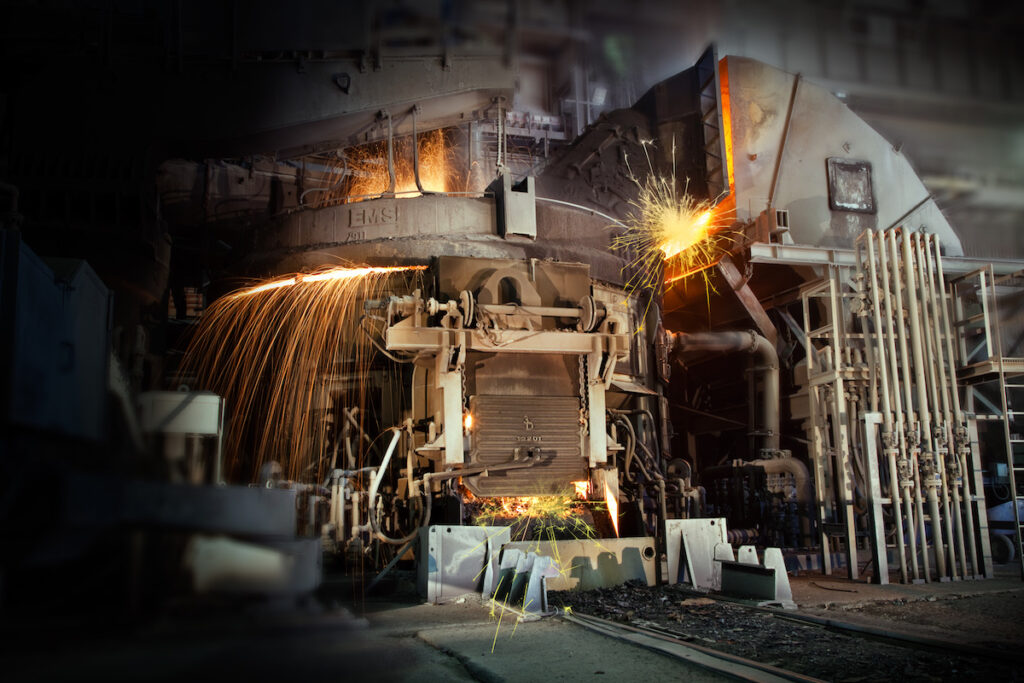BuildSteel is tracking the sustainability initiatives led by various members of the steel framing industry. Here is some recent sustainability news related to cold-formed steel (CFS) framing.
ArcelorMittal Dofasco Breaks Ground on Low-Carbon Project
In October, ArcelorMittal broke broken ground on its CAD$1.8 billion investment decarbonization project at the ArcelorMittal Dofasco plant in Hamilton, Ontario, Canada. ArcelorMittal Dofasco is a member of the Steel Framing Industry Association.
The project, a partnership between ArcelorMittal and the governments of Canada and Ontario will play an important role in ensuring the company makes progress this decade with its decarbonization efforts, which includes reducing the carbon intensity of the steel it produces by 25% by 2030.

Ron Bedard, president and CEO of ArcelorMittal Dofasco, speaks at the groundbreaking ceremony for the company’s low-carbon emissions steelmaking project in Canada. Photo courtesy of ArcelorMittal Dofasco
The project will fundamentally change the way steel is made at ArcelorMittal Dofasco, transitioning the site to direct reduced iron-electric arc furnace (DRI-EAF) steelmaking, which carries a considerably lower carbon footprint and removes coal from the ironmaking process. The new 2.5-million-ton capacity DRI furnace will initially operate on natural gas but will be constructed “hydrogen ready” so it can be transitioned to use green hydrogen as a clean energy input as and when a sufficient, cost-effective supply of green hydrogen becomes available.
Speaking at the event, Canadian Prime Minister Trudeau said: “ArcelorMittal Dofasco’s steel plant is not just a cornerstone of the Canadian economy and the Hamilton community – it’s an example to the world of what clean innovation will look like.”
Ron Bedard, president and CEO of ArcelorMittal Dofasco, said: “This project provides us with a tremendous opportunity to transition ArcelorMittal Dofasco into one of the world’s cleanest, lowest carbon and modern steel manufacturers. While it involves installing new technology and equipment, the investment is really about people and planet. It will help our customers lower their carbon footprint, ensuring they deliver low carbon products to consumers.”
Read the complete news release here.
AISI Releases GHG Emission Guidelines
As reported recently by BuildSteel, the American Iron and Steel Institute has released recommended steel industry greenhouse gas (GHG) emissions calculation guidelines to provide consistent and comprehensive data across the industry on GHG emissions from steel production.
The AISI’s proposed guidelines focus on product-level disclosures and corporate-level reporting and are the result of a months-long collaboration with key American steel producers and Institute staff. Download the AISI recommended GHG emission calculation guidelines.
“The American steel industry’s leadership on reducing emissions is well-known, but there are often disparate sources and avenues for calculating and reporting. Our industry wants to remain transparent, accurate and outspoken in our advocacy on decarbonization-related activities — and these guidelines can be an important tool to achieve those goals,” said Kevin Dempsey, AISI president and CEO.
The AISI recommendations for GHG emissions calculations include all processing steps required to manufacture a defined product. They are based on the EPA GHG Reporting Rule methodology for U.S.-based facilities. When calculating electricity emissions factors, calculations should be based on local electricity grid factors. And, in general, emissions should be calculated at the product level for trade, procurement and environmental product declarations.
Readers can consult the original AISI news release and get complete guidelines details here.
Nucor Focuses on Safe, Sustainable Steel
Nucor Corporation, a Charlotte, N.C., steel products manufacturer and SFIA member, sponsored a steel sustainability article recently on the website 10/12 Industry Report that discusses the company’s efforts to deliver safe and sustainable steel.
The article, “Sustainable Steel: Nucor leading the way in low-carbon steel production to build our modern economy,” featured Nucor Steel Louisiana’s facility in St. James Parish. The Nucor facility produces natural gas-based direct reduced iron (DRI), which is blended with recycled scrap from Nucor’s steel mills to make higher grades of steel.
“DRI is made from high-grade iron ore reduced by natural gas at extremely high temperatures to provide highly-metallicized refined iron pellets,” the article says. “By using natural gas, our DRI plant emits only half of the CO2 compared to iron produced in blast furnaces at traditional integrated steel mills. Following production, DRI is shipped by barge on the Mississippi River from the St. James facility to Nucor steel mills nationwide.”
Nucor is a pioneer in the process of making steel in the U.S. by recycling scrap metal in Electric Arc Furnaces (EAFs), the article says. Last year, the company recycled nearly 23 million tons of ferrous scrap metal to produce new steel that is 100% recyclable.
“Our goal is to be the safest and most sustainable steel company in the world. Nucor has invested more than $15 billion dollars in the U.S. over the last decade to grow our portfolio of sustainably made steel products,” said Calvin Hart, general manager, Nucor Steel Louisiana.
Today, more than 70% of steel made in the U.S. is produced in EAFs, making this country the cleanest place in the world to produce steel, the Nucor article says.
CFS Meets All Sustainability Requirements
Cold-formed steel (CFS) meets the highest sustainability requirements set in all major green building standards and rating programs, including the Leadership in Energy and Environmental Design (LEED®) from the U.S. Green Building Council, the National Green Building Standard (ICC-700) for residential buildings, ASHRAE Standard 189.1 for commercial construction and the International Green Construction Code (IgCC). According to the American Iron and Steel Institute:
- Steel framing contains a minimum of 25% recycled steel and is continually and completely “remade without any loss of quality”
- Most other construction products can only be down-cycled into lower-quality products
- Steel framing minimizes construction site waste
Additional Resources
- Update #3 | Steel Framing Industry Sustainability Initiatives
- Update #2 | Steel Framing Industry Sustainability Initiatives
- Update #1 | Steel Framing Industry Sustainability Initiatives


